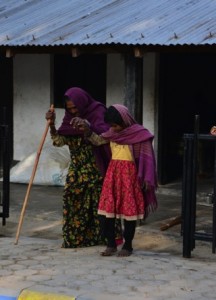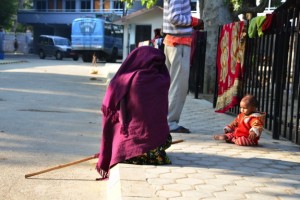How Local Eye Care Access Could Have Helped Save a Grandmother’s Sight


Sadly, cases of blindness and truly unnecessary suffering go hand in hand with the double blight of being poor and living in India, a country without adequate eye care nearby.
On a recent trip to Nepal I saw a much too frequent, sorrowful scene unfold as a young child helped a blind elderly adult outside the Nepali forest-based eye hospital known as Geta. As hundreds of patients were waiting optimistically in a long line to register for eye care, I watched as two Indians, grandmother and granddaughter, emerged from inside a concrete sleeping shell on the hospital grounds. The young girl deposited the blind woman on the curb in the sun and went back into the shelter. The woman promptly covered herself with her shawl.
It was apparent to us that another family was also staying in the same hut. As the blind woman sat dejectedly on the concrete, the child of the other family had grabbed her stick to play with it. She quickly snatched it back and basically sat on it without ever pulling her shawl back from her head; it would not have mattered since she could not see anything.

The woman had been sighted in her right eye but was completely blind in her left eye. At some point in her recent past, she had been working in a sugarcane field when a fibrous sugarcane leaf snapped back, striking and injuring her good eye.
This is an all too common story, as the blog I wrote on Babu Ram in a post in November 2012 recounted essentially the same story. Babu Ram, like this woman, had been struck in his one sighted eye. This type of injury happens because when a person has sight in only one eye, the other, blind eye cannot perceive the threat of something like leaves snapping back and that lack of reaction often leads to a damaging impact to the person’s good eye.

She and her granddaughter would have to stay for more treatment but her son had run out of money. He had returned to his village in India to work and save more money, leaving the two women to fend for themselves as best they could. The bus fare to get to Nepal from their village had cost 900 Indian rupees. The treatment so far at the hospital was only 500 Nepali rupees, or about 320 Indian rupees.
Added Burden of Transportation Costs
As is often the case, the most expensive aspect of treatment for eye care is not the medical care but the hard cash needed for transportation. This sad patient care event illustrates how transporting women to hospitals is often much more expensive in poor countries than the actual treatment they will need. This is because this family had to purchase three tickets, not one. A man would have been able to come alone or with one other person, but women cannot travel safely on their own to get medical treatment.

On the day we spoke with them, these two women had no money and had not eaten that day. They were not sure when the son would come back from India with more money for food and continued eye care for the grandmother. I was able to have Om 500 rupees to give to the grandmother for food and continued care while they waited for her son to return.
She was told that she might possibly be able to have her white cataract removed from her left eye once the infection had cleared. It might take weeks for the situation to be sterilized enough to be safe to proceed. In the meantime the granddaughter has dropped out of school to be full time guide-child for her grandmother.
The Geta Hospital has a fund to pay for patients who need cataract surgery. The patients still need to pay transportation and food so it is again quite cash challenging for these rural Indians to get back to Nepal to get eye surgery. There is some hope for this woman with surgery on her “light perception” cataractous left eye. However, there is no guarantee that the other eye could have useful vision once the cataract is removed.
